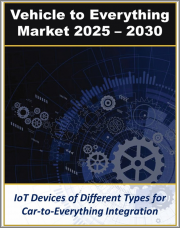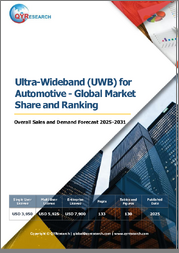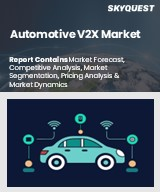
|
시장보고서
상품코드
1781508
세계의 자동차 V2X 기술 시장 조사 보고서 : 산업 분석, 규모, 점유율, 성장, 동향 및 예측(2025-2033년)Global Automotive V2X Technology Market Research Report- Industry Analysis, Size, Share, Growth, Trends and Forecast 2025 to 2033 |
||||||
세계의 자동차 V2X 기술 시장 규모는 2024년 22억 3,000만 달러에서 2033년에는 141억 9,000만 달러로 성장할 것으로 예측되며, 2026-2033년의 예측 기간 중에 22.83%의 연평균 복합 성장률(CAGR)을 나타낼 전망입니다.
자동차 V2X(Vehicle-to-Everything) 기술 시장은 자동차 산업이 커넥티비티와 자동화를 점점 더 많이 수용함에 따라 혁신적으로 성장하고 있습니다. 이 기술은 차량과 인프라, 보행자, 다른 차량 등 주변 환경과의 통신을 용이하게 하여 도로의 안전성과 효율성을 높입니다. 스마트시티가 진화하고 자율주행차에 대한 수요가 증가함에 따라 V2X 시스템 통합이 가장 중요해집니다. 5G 네트워크와 첨단 센서 기술의 융합은 V2X의 기능을 더욱 강화하여 실시간 데이터 교환과 의사결정 과정을 가능하게 함으로써 교통 체증과 사고를 크게 줄일 수 있습니다.
또한, V2X 기술의 보급을 뒷받침하는 규제 상황도 진화하고 있습니다. 세계 각국 정부는 커넥티드카가 교통안전 향상과 배출가스 감축에 기여할 수 있는 가능성을 인식하고 있습니다. 통신 프로토콜의 표준화와 사이버 보안 대책 강화를 위한 노력은 V2X 시스템을 기존 교통 네트워크에 원활하게 통합할 수 있는 길을 열어줄 것으로 보입니다. 자동차 제조업체들이 연구개발에 많은 투자를 하고 있는 가운데, IoT 및 AI를 전문으로 하는 하이테크 기업과의 제휴는 혁신을 가속화하고 다양한 시장 수요에 대응하는 보다 정교한 V2X 솔루션을 창출할 수 있을 것으로 보입니다.
또한, V2X 시스템 관련 이점에 대한 인식이 높아지면서 커넥티드 차량 기술에 대한 소비자의 수용도 증가하고 있습니다. 충돌방지, 교통신호 우선순위 지정, 내비게이션 강화 등의 기능이 보편화됨에 따라 시장에서는 V2X 기능이 탑재된 차량에 대한 수요가 급증할 것으로 보입니다. 자동차 V2X 기술 시장의 미래는 차량 성능의 향상뿐만 아니라 운송의 안전성, 효율성, 지속가능성을 우선시하는 종합적인 생태계를 구축하는 것이 중요합니다.
당사의 보고서는 고객에게 다양한 산업과 시장에 대한 종합적이고 실용적인 통찰력을 제공하기 위해 세심하게 작성되었습니다. 각 보고서는 시장 상황을 완전히 이해하기 위해 몇 가지 중요한 요소를 포함하고 있습니다.
시장 개요: 정의, 분류, 산업 현황 등 시장에 대한 자세한 소개.
시장 역학: 시장 성장에 영향을 미치는 주요 촉진요인, 억제요인, 기회 및 과제를 상세하게 분석합니다. 이 섹션에서는 기술 발전, 규제 변화, 새로운 트렌드 등의 요인을 살펴봅니다.
세분화 분석 : 제품 유형, 용도, 최종 사용자, 지역 등의 기준에 따라 시장을 명확한 부문으로 세분화합니다. 이 분석을 통해 각 부문의 실적과 미래성을 파악할 수 있습니다.
경쟁 구도: 시장 점유율, 제품 포트폴리오, 전략적 이니셔티브, 재무 실적 등 주요 시장 진출기업의 종합적인 평가. 주요 기업들이 채택하고 있는 경쟁 역학 및 주요 전략에 대한 고찰을 담고 있습니다.
시장 예측 : 과거 데이터와 현재 시장 상황을 바탕으로 일정 기간 시장 규모와 성장 추세를 예측합니다. 여기에는 정량적 분석과 미래 시장 궤적을 보여주는 그래프 표시가 포함됩니다.
지역 분석 : 지역별 시장 성과를 평가하고 주요 시장 및 지역 동향을 파악합니다. 지역 시장 역학 및 비즈니스 기회를 이해하는 데 도움이 됩니다.
새로운 트렌드와 기회 : 현재 시장 동향과 새로운 시장 동향, 기술 혁신, 잠재적 투자 대상 부문을 식별합니다. 향후 개발 및 성장 전망에 대한 통찰력을 담고 있습니다.
목차
제1장 서문
제2장 주요 요약
- 시장 하이라이트
- 세계 시장 현황
제3장 자동차 V2X 기술 산업 분석
- 서론 : 시장 역학
- 시장 성장 촉진요인
- 시장 성장 억제요인
- 시장 기회
- 산업 동향
- Porter의 Five Forces 분석
- 시장 매력 분석
제4장 밸류체인 분석
- 밸류체인 분석
- 원료 분석
- 원료 리스트
- 원료 제조업체 리스트
- 주요 원료 가격 동향
- 잠재적 바이어 리스트
- 마케팅 채널
- 직접 마케팅
- 간접 마케팅
- 마케팅 채널 발전 동향
제5장 세계의 자동차 V2X 기술 시장 분석 : 통신 유형별
- 통신 유형별 개요
- 통신 유형별 과거 및 예측 데이터 분석
- Vehicle-to-Vehicle (V2V)
- Vehicle-to-Infrastructure (V2I)
- Vehicle-to-Pedestrian (V2P)
- Vehicle-to-Device (V2D)
- Vehicle-to-Grid (V2G)
- Vehicle-to-Network (V2N)
제6장 세계의 자동차 V2X 기술 시장 분석 : 접속성별
- 접속성별 개요
- 접속성별 과거 및 예측 데이터 분석
- 전용 단거리 통신(DSRC)
- 셀룰러
제7장 세계의 자동차 V2X 기술 시장 분석 : 차종별
- 차종별 개요
- 차종별 과거 및 예측 데이터 분석
- 승용차
- 상용차
제8장 세계의 자동차 V2X 기술 시장 분석 : 용도별
- 용도별 개요
- 용도별 과거 및 예측 데이터 분석
- 안전
- 교통 관리
- 인포테인먼트
- 결제
- 기타
제9장 세계의 자동차 V2X 기술 시장 분석 : 지역별
- 지역별 전망
- 서론
- 북미의 판매 분석
- 개요, 분석과 예측
- 북미 : 부문별
- 북미 : 국가별
- 미국
- 캐나다
- 멕시코
- 유럽의 판매 분석
- 개요, 분석과 예측
- 유럽 : 부문별
- 유럽 : 국가별
- 영국
- 프랑스
- 독일
- 이탈리아
- 러시아
- 기타 유럽
- 아시아태평양의 판매 분석
- 개요, 분석과 예측
- 아시아태평양 : 부문별
- 아시아태평양 : 국가별
- 중국
- 인도
- 일본
- 한국
- 호주
- 동남아시아
- 기타 아시아태평양
- 라틴아메리카의 판매 분석
- 개요, 분석과 예측
- 라틴아메리카 : 부문별
- 라틴아메리카 : 국가별
- 브라질
- 아르헨티나
- 페루
- 칠레
- 기타 라틴아메리카
- 중동 및 아프리카의 판매 분석
- 개요, 분석과 예측
- 중동 및 아프리카 : 부문별
- 중동 및 아프리카 : 국가별
- 사우디아라비아
- 아랍에미리트(UAE)
- 이스라엘
- 남아프리카공화국
- 기타 중동 및 아프리카
제10장 자동차 V2X 기술 기업 경쟁 구도
- 자동차 V2X 기술 시장 경쟁
- 제휴/협력/계약
- 인수합병(M&A)
- 신제품 발표
- 기타 개발
제11장 기업 개요
- 주요 기업의 시장 점유율 분석
- 시장 집중도
- Qualcomm Technologies Inc.
- Continental AG
- Robert Bosch GmbH
- DENSO Corporation
- NXP Semiconductors N.V.
- Autotalks Ltd.
- Cohda Wireless Pty Ltd.
- Savari Inc.
- Harman International Industries Inc.
- Infineon Technologies AG
- STMicroelectronics N.V.
- Lear Corporation
- Valeo S.A.
- Hyundai Mobis Co. Ltd.
- Huawei Technologies Co. Ltd
Global Automotive V2X Technology Market size is anticipated to grow from USD 2.23 Billion in 2024 to USD 14.19 Billion by 2033, showcasing a robust Compound Annual Growth Rate (CAGR) of 22.83% during the forecast period of 2026 to 2033.
The Automotive V2X (Vehicle-to-Everything) technology market is poised for transformative growth as the automotive industry increasingly embraces connectivity and automation. This technology facilitates communication between vehicles and their surroundings, including infrastructure, pedestrians, and other vehicles, thereby enhancing safety and efficiency on the roads. As smart cities evolve and the demand for autonomous vehicles escalates, the integration of V2X systems will become paramount. The convergence of 5G networks and advanced sensor technologies will further bolster the capabilities of V2X, enabling real-time data exchange and decision-making processes that significantly reduce traffic congestion and accidents.
Moreover, the regulatory landscape is evolving to support the widespread adoption of V2X technology. Governments worldwide are recognizing the potential of connected vehicles to improve road safety and reduce emissions. Initiatives aimed at standardizing communication protocols and enhancing cybersecurity measures will pave the way for seamless integration of V2X systems into existing transportation networks. As automotive manufacturers invest heavily in research and development, partnerships with tech companies specializing in IoT and AI will accelerate innovation, leading to the creation of more sophisticated V2X solutions that cater to diverse market needs.
In addition, consumer acceptance of connected vehicle technologies is on the rise, driven by the increasing awareness of the benefits associated with V2X systems. As features such as collision avoidance, traffic signal prioritization, and enhanced navigation become commonplace, the market will witness a surge in demand for vehicles equipped with V2X capabilities. The future of the Automotive V2X technology market is not only about enhancing vehicle performance but also about creating a holistic ecosystem that prioritizes safety, efficiency, and sustainability in transportation.
Our reports are meticulously crafted to provide clients with comprehensive and actionable insights into various industries and markets. Each report encompasses several critical components to ensure a thorough understanding of the market landscape:
Market Overview: A detailed introduction to the market, including definitions, classifications, and an overview of the industry's current state.
Market Dynamics: In-depth analysis of key drivers, restraints, opportunities, and challenges influencing market growth. This section examines factors such as technological advancements, regulatory changes, and emerging trends.
Segmentation Analysis: Breakdown of the market into distinct segments based on criteria like product type, application, end-user, and geography. This analysis highlights the performance and potential of each segment.
Competitive Landscape: Comprehensive assessment of major market players, including their market share, product portfolio, strategic initiatives, and financial performance. This section provides insights into the competitive dynamics and key strategies adopted by leading companies.
Market Forecast: Projections of market size and growth trends over a specified period, based on historical data and current market conditions. This includes quantitative analyses and graphical representations to illustrate future market trajectories.
Regional Analysis: Evaluation of market performance across different geographical regions, identifying key markets and regional trends. This helps in understanding regional market dynamics and opportunities.
Emerging Trends and Opportunities: Identification of current and emerging market trends, technological innovations, and potential areas for investment. This section offers insights into future market developments and growth prospects.
SEGMENTATION COVERED IN THE REPORT
By Communication Type
- Vehicle-to-Vehicle (V2V)
- Vehicle-to-Infrastructure (V2I)
- Vehicle-to-Pedestrian (V2P)
- Vehicle-to-Device (V2D)
- Vehicle-to-Grid (V2G)
- Vehicle-to-Network (V2N)
By Connectivity
- Dedicated Short Range Communication (DSRC)
- Cellular
By Vehicle Type
- Passenger Cars
- Commercial Vehicles
By Application
- Safety
- Traffic Management
- Infotainment
- Payments
- Others
- COMPANIES PROFILED
- Qualcomm Technologies Inc.
- Continental AG
- Robert Bosch GmbH
- DENSO Corporation
- NXP Semiconductors N.V.
- Autotalks Ltd.
- Cohda Wireless Pty Ltd.
- Savari Inc.
- Harman International Industries Inc.
- Infineon Technologies AG
- STMicroelectronics N.V.
- Lear Corporation
- Valeo S.A.
- Hyundai Mobis Co. Ltd.
- Huawei Technologies Co. Ltd.
- The above list can be customized.
TABLE OF CONTENTS
1. PREFACE
- 1.1. Report Description
- 1.1.1 Objective
- 1.1.2 Target Audience
- 1.1.3 Unique Selling Proposition (USP) & offerings
- 1.2. Research Scope
- 1.3. Research Methodology
- 1.3.1 Market Research Process
- 1.3.2 Market Research Methodology
2. EXECUTIVE SUMMARY
- 2.1. Highlights of Market
- 2.2. Global Market Snapshot
3. AUTOMOTIVE V2X TECHNOLOGY INDUSTRY ANALYSIS
- 3.1. Introduction - Market Dynamics
- 3.2. Market Drivers
- 3.3. Market Restraints
- 3.4. Opportunities
- 3.5. Industry Trends
- 3.6. Porter's Five Force Analysis
- 3.7. Market Attractiveness Analysis
- 3.7.1 Market Attractiveness Analysis By Communication Type
- 3.7.2 Market Attractiveness Analysis By Connectivity
- 3.7.3 Market Attractiveness Analysis By Vehicle Type
- 3.7.4 Market Attractiveness Analysis By Application
- 3.7.5 Market Attractiveness Analysis By Regions
4. VALUE CHAIN ANALYSIS
- 4.1. Value Chain Analysis
- 4.2. Raw Material Analysis
- 4.2.1 List of Raw Materials
- 4.2.2 Raw Material Manufactures List
- 4.2.3 Price Trend of Key Raw Materials
- 4.3. List of Potential Buyers
- 4.4. Marketing Channel
- 4.4.1 Direct Marketing
- 4.4.2 Indirect Marketing
- 4.4.3 Marketing Channel Development Trend
5. GLOBAL AUTOMOTIVE V2X TECHNOLOGY MARKET ANALYSIS BY COMMUNICATION TYPE
- 5.1. Overview By Communication Type
- 5.2. Historical and Forecast Data Analysis By Communication Type
- 5.3. Vehicle-to-Vehicle (V2V) Historic and Forecast Sales By Regions
- 5.4. Vehicle-to-Infrastructure (V2I) Historic and Forecast Sales By Regions
- 5.5. Vehicle-to-Pedestrian (V2P) Historic and Forecast Sales By Regions
- 5.6. Vehicle-to-Device (V2D) Historic and Forecast Sales By Regions
- 5.7. Vehicle-to-Grid (V2G) Historic and Forecast Sales By Regions
- 5.8. Vehicle-to-Network (V2N) Historic and Forecast Sales By Regions
6. GLOBAL AUTOMOTIVE V2X TECHNOLOGY MARKET ANALYSIS BY CONNECTIVITY
- 6.1. Overview By Connectivity
- 6.2. Historical and Forecast Data Analysis By Connectivity
- 6.3. Dedicated Short Range Communication (DSRC) Historic and Forecast Sales By Regions
- 6.4. Cellular Historic and Forecast Sales By Regions
7. GLOBAL AUTOMOTIVE V2X TECHNOLOGY MARKET ANALYSIS BY VEHICLE TYPE
- 7.1. Overview By Vehicle Type
- 7.2. Historical and Forecast Data Analysis By Vehicle Type
- 7.3. Passenger Cars Historic and Forecast Sales By Regions
- 7.4. Commercial Vehicles Historic and Forecast Sales By Regions
8. GLOBAL AUTOMOTIVE V2X TECHNOLOGY MARKET ANALYSIS BY APPLICATION
- 8.1. Overview By Application
- 8.2. Historical and Forecast Data Analysis By Application
- 8.3. Safety Historic and Forecast Sales By Regions
- 8.4. Traffic Management Historic and Forecast Sales By Regions
- 8.5. Infotainment Historic and Forecast Sales By Regions
- 8.6. Payments Historic and Forecast Sales By Regions
- 8.7. Others Historic and Forecast Sales By Regions
9. GLOBAL AUTOMOTIVE V2X TECHNOLOGY MARKET ANALYSIS BY GEOGRAPHY
- 9.1. Regional Outlook
- 9.2. Introduction
- 9.3. North America Sales Analysis
- 9.3.1 Overview, Historic and Forecast Data Sales Analysis
- 9.3.2 North America By Segment Sales Analysis
- 9.3.3 North America By Country Sales Analysis
- 9.3.4 United States Sales Analysis
- 9.3.5 Canada Sales Analysis
- 9.3.6 Mexico Sales Analysis
- 9.4. Europe Sales Analysis
- 9.4.1 Overview, Historic and Forecast Data Sales Analysis
- 9.4.2 Europe By Segment Sales Analysis
- 9.4.3 Europe By Country Sales Analysis
- 9.4.4 United Kingdom Sales Analysis
- 9.4.5 France Sales Analysis
- 9.4.6 Germany Sales Analysis
- 9.4.7 Italy Sales Analysis
- 9.4.8 Russia Sales Analysis
- 9.4.9 Rest Of Europe Sales Analysis
- 9.5. Asia Pacific Sales Analysis
- 9.5.1 Overview, Historic and Forecast Data Sales Analysis
- 9.5.2 Asia Pacific By Segment Sales Analysis
- 9.5.3 Asia Pacific By Country Sales Analysis
- 9.5.4 China Sales Analysis
- 9.5.5 India Sales Analysis
- 9.5.6 Japan Sales Analysis
- 9.5.7 South Korea Sales Analysis
- 9.5.8 Australia Sales Analysis
- 9.5.9 South East Asia Sales Analysis
- 9.5.10 Rest Of Asia Pacific Sales Analysis
- 9.6. Latin America Sales Analysis
- 9.6.1 Overview, Historic and Forecast Data Sales Analysis
- 9.6.2 Latin America By Segment Sales Analysis
- 9.6.3 Latin America By Country Sales Analysis
- 9.6.4 Brazil Sales Analysis
- 9.6.5 Argentina Sales Analysis
- 9.6.6 Peru Sales Analysis
- 9.6.7 Chile Sales Analysis
- 9.6.8 Rest of Latin America Sales Analysis
- 9.7. Middle East & Africa Sales Analysis
- 9.7.1 Overview, Historic and Forecast Data Sales Analysis
- 9.7.2 Middle East & Africa By Segment Sales Analysis
- 9.7.3 Middle East & Africa By Country Sales Analysis
- 9.7.4 Saudi Arabia Sales Analysis
- 9.7.5 UAE Sales Analysis
- 9.7.6 Israel Sales Analysis
- 9.7.7 South Africa Sales Analysis
- 9.7.8 Rest Of Middle East And Africa Sales Analysis
10. COMPETITIVE LANDSCAPE OF THE AUTOMOTIVE V2X TECHNOLOGY COMPANIES
- 10.1. Automotive V2X Technology Market Competition
- 10.2. Partnership/Collaboration/Agreement
- 10.3. Merger And Acquisitions
- 10.4. New Product Launch
- 10.5. Other Developments
11. COMPANY PROFILES OF AUTOMOTIVE V2X TECHNOLOGY INDUSTRY
- 11.1. Top Companies Market Share Analysis
- 11.2. Market Concentration Rate
- 11.3. Qualcomm Technologies Inc.
- 11.3.1 Company Overview
- 11.3.2 Company Revenue
- 11.3.3 Products
- 11.3.4 Recent Developments
- 11.4. Continental AG
- 11.4.1 Company Overview
- 11.4.2 Company Revenue
- 11.4.3 Products
- 11.4.4 Recent Developments
- 11.5. Robert Bosch GmbH
- 11.5.1 Company Overview
- 11.5.2 Company Revenue
- 11.5.3 Products
- 11.5.4 Recent Developments
- 11.6. DENSO Corporation
- 11.6.1 Company Overview
- 11.6.2 Company Revenue
- 11.6.3 Products
- 11.6.4 Recent Developments
- 11.7. NXP Semiconductors N.V.
- 11.7.1 Company Overview
- 11.7.2 Company Revenue
- 11.7.3 Products
- 11.7.4 Recent Developments
- 11.8. Autotalks Ltd.
- 11.8.1 Company Overview
- 11.8.2 Company Revenue
- 11.8.3 Products
- 11.8.4 Recent Developments
- 11.9. Cohda Wireless Pty Ltd.
- 11.9.1 Company Overview
- 11.9.2 Company Revenue
- 11.9.3 Products
- 11.9.4 Recent Developments
- 11.10. Savari Inc.
- 11.10.1 Company Overview
- 11.10.2 Company Revenue
- 11.10.3 Products
- 11.10.4 Recent Developments
- 11.11. Harman International Industries Inc.
- 11.11.1 Company Overview
- 11.11.2 Company Revenue
- 11.11.3 Products
- 11.11.4 Recent Developments
- 11.12. Infineon Technologies AG
- 11.12.1 Company Overview
- 11.12.2 Company Revenue
- 11.12.3 Products
- 11.12.4 Recent Developments
- 11.13. STMicroelectronics N.V.
- 11.13.1 Company Overview
- 11.13.2 Company Revenue
- 11.13.3 Products
- 11.13.4 Recent Developments
- 11.14. Lear Corporation
- 11.14.1 Company Overview
- 11.14.2 Company Revenue
- 11.14.3 Products
- 11.14.4 Recent Developments
- 11.15. Valeo S.A.
- 11.15.1 Company Overview
- 11.15.2 Company Revenue
- 11.15.3 Products
- 11.15.4 Recent Developments
- 11.16. Hyundai Mobis Co. Ltd.
- 11.16.1 Company Overview
- 11.16.2 Company Revenue
- 11.16.3 Products
- 11.16.4 Recent Developments
- 11.17. Huawei Technologies Co. Ltd
- 11.17.1 Company Overview
- 11.17.2 Company Revenue
- 11.17.3 Products
- 11.17.4 Recent Developments



















